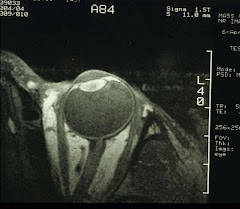The color of the iris is determined by the proportion of two pigments, melanin (brown, controlled by chromosome 15) and lipochrome (yellowish brown, chromosome 19). A blue eye looks blue is because it has less melanin than lipochrome and less pigments in general. And the more melanin, the darker the iris. An iris without pigments would appear pale pink. A cross section of the iris is shown below:
 The cornea (not shown) is to the left. The dark vertical structure in this image is the iris proper and the pink area to its right is the crystalline lens. In the posterior part of the iris, the darker band is the pigment epithelium with all the pigments. Without shielding from much melanin, blue eyes are inherently more sensitive to bright lights. Dark irises are pharmacologically more resistant to dilating eyedrops, however.
The cornea (not shown) is to the left. The dark vertical structure in this image is the iris proper and the pink area to its right is the crystalline lens. In the posterior part of the iris, the darker band is the pigment epithelium with all the pigments. Without shielding from much melanin, blue eyes are inherently more sensitive to bright lights. Dark irises are pharmacologically more resistant to dilating eyedrops, however.You can have one hazel eye and the other brown, too - known as heterochromia. Presumably Alexander the Great (356-323 BC) was heterochromic. This happens when one iris fails to generate enough melanin. It can be hereditary or from childhood trauma to the sympathetic nerve along the carotid artery. One can imagine someone (King Philip II?) picked up little Al by the head in a Macedonian horseplay, thereby causing the said injury. To all the dads/uncles out there: please don't do this to the little ones.
Sometimes, however, the pigments can get dislodged, as seen below in a retro-illumination photo. In which the light is reflected through the backside of the iris. And in the posterior surface of the cornea, a vertical band of pigments also appears (i.e., the Krukenberg's spindle).
This is known as pigmentation dispersion syndrome. If the pigments clog up the aqueous outflow, the intraocular pressure can rise, then we have the pigmentary glaucoma. Often filtration surgery is needed.
The pupils of all humans are round. Animals are not all so. Some animals have vertical pupils while others horizontal ones. They can be slits, ovals, or even W-shaped. And the reason why all these different shapes? You can propose your own theory and whatever it is, is probably right. It is usually something like slit pupils can shut quicker than round ones, nocturnal animals have vertical pupils to detect a prey scurrying away, and horizontal slits are better for navigating rocky terrains, etc.
Here are a few examples:
 Above: Vertically oval pupil in an alligator, also seen in cats and some lizards. And below: horizontal slits in a goat (also in octopuses).
Above: Vertically oval pupil in an alligator, also seen in cats and some lizards. And below: horizontal slits in a goat (also in octopuses). And a W-shaped pupil found only in the cuttlefish:
And a W-shaped pupil found only in the cuttlefish: Other than it looks like a miniature Batman symbol, a reasonable explanation is still lacking.
Other than it looks like a miniature Batman symbol, a reasonable explanation is still lacking.In humans, some are born without the iris (i.e., aniridia). Supposedly, during Renaissance, the courtesans would take Belladonna extracts (rich in scopolamine and atropine) to maximally dilate their pupils - to make the eyes more attractive. And the pupils are sometimes re-shaped by trauma from, e.g., recoiling bungee cords with a metal hook, or playing paintballs without the goggles. Or more frequently by surgery, e.g., during cataract removal (see image below):
 Then we may have a case of light and glare sensitivity because the iris no longer functions normally. And sometimes a small opening in the iris is created to facilitate aqueous flow as a treatment for chronic narrow-angle glaucoma (see the small hole, 11 o'clock position, from laser iridotomy):
Then we may have a case of light and glare sensitivity because the iris no longer functions normally. And sometimes a small opening in the iris is created to facilitate aqueous flow as a treatment for chronic narrow-angle glaucoma (see the small hole, 11 o'clock position, from laser iridotomy): The iris is such an interesting structure, some have gone further and developed iris-reading (as in palm-reading):
The iris is such an interesting structure, some have gone further and developed iris-reading (as in palm-reading): Although it is still unclear, for example, why/how/where/when the iris sphinctor muscle area should be associated with the digestive tract (and so on).
Although it is still unclear, for example, why/how/where/when the iris sphinctor muscle area should be associated with the digestive tract (and so on).












2 comments:
Dear eye doc:
You surely are open up my understanding of eyes, even some animal eyes. Thanks a million!
Just how the shapes of pupil opening are different are interesting to think about.
Don't other animals look at us humans and think we are the odd ones? They surely have their different perspectives, so to speak.
Thanks!
BH
Dear BH:
You are welcome.
We really don't know how animals see humans as. Koko the gorilla did know the ASL for "ugly". Maybe that is a hint.
EyeDoc
Post a Comment